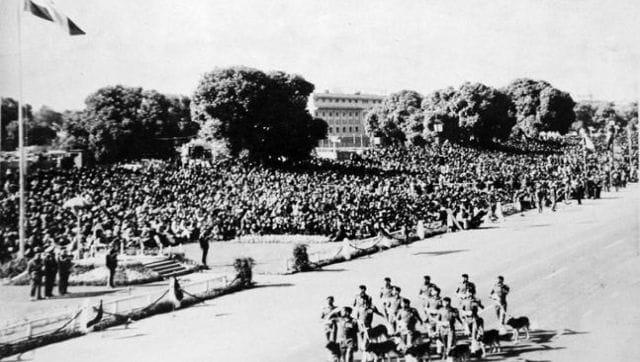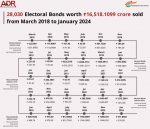Tomorrow (26 January), India will mark its 75th Republic Day. One of the most enduring parts of celebrations of this day is the impressive Republic Day Parade on Kartavya Path (formerly known as Rajpath).
The grand parade will feature several contingents from the Army, Navy, Air Force and other para-military branches, along with impressive displays of military equipment, including tanks, missiles and fighter jets. This year, the President of France, Emmanuel Macron, will be the chief guest at the Republic Day parade after being invited for the celebrations.
But why do Republic Day celebrations include a parade? What is the connection between a military parade and the adoption of the Constitution?
We explain.
The history of military parades
To understand why India has a military parade on the occasion of Republic Day, one has to first dive into the history of such parades. For generations and generations, rulers have used military parades as a way to display its strength and triumph over others.
Historical accounts reveal that in ancient Mesopotamia, kings lined their cities with murals depicting glorious conquests. One account reveals that warrior kings marched through the sacred Gate of Ishtar in Babylon, which was flanked by 60 lion statues.
During the Roman empire, victorious generals marched from the Field of Mars past shrines towards Rome’s great Temple of Jupiter, all while the public roared and gave them a rousing welcome. Historians reveal that bulls were sacrificed, laurel wreaths were donned and some of the slaves who were captured have to chant — ‘Memento mori’ (Remember you are mortal) to their captors.
The logic behind these instances was to boost a king’s prestige and cement his political authority.
As time passed by and modern countries came into being, this norm of a military parade was adapted and modernised. It is said that Prussia (consisting a large part of today’s Germany) was the pioneer of the modern military parade. In fact, the ‘goose step’ — a ceremonial march — that has become a symbol of the Nazi army, can be traced back to Prussia.
Other countries soon followed suit with their own parades and today, China, Russia, France and North Korea have their own military parades.
India’s history with military parades
While India witnesses a military parade each year on Republic Day, the country has a long history of them. During the British Raj, royal parades and processions were a regular occurrence. Historians note that these were done not only to put on display the British Empire’s dominance to the Indian crowds, but also to other European rivals.
When India gained Independence in 1947, it continued with several of the British traditions — one of the most notable being the military parade.
And when India became a Republic in 1950 — adopting a Constitution, marking the end of India’s ties to the British empire — the country’s leaders decided to have a parade to commemorate the moment with a parade. Their thinking at that time was the parade would be a symbol of India’s victory over the colonial rule and an indication of a rise of a new, strong republic.
Moreover, the parade would show the world that India would not shy away on the global stage and had the firepower to defend its land from future enemies.
And with this in mind, on 26 January 1950, India held its first Republic Day parade. Notably, that parade was held at the Irwin Amphitheatre (presently known as the Major Dhyan Chand National Stadium) which also saw the swearing-in ceremony of India’s first president — Dr Rajendra Prasad.
Historian Ramchandra Guha in his book, India After Gandhi, wrote of the first R-Day parade, “Three thousand men of the armed forces marched before the president. The artillery fired a thirty-one gun salute while Liberator planes of the Indian air force flew overhead.”
Also read: How India rang in its first Republic Day in 1950
And just as Macron is India’s chief guest for this year’s parade, the first also had a special guest in the form of Indonesia’s president, Sukarno.
It was in the following year that the location was shifted to Rajpath, now renamed as Kartavya Path.
In the coming years, India also invited states to take part in a cultural pageant that became a part of the parade. Explaining this change, academic Suchitra Balasubrahmanyan told BBC, “It was a period of tension when linguistic and regional assertions were making their presence felt.”
And by adding the cultural aspect to the parade, it became “an even more vital symbol of presenting an image of a diverse but united country – a viable, cohesive national identity.”
Historian Srinath Raghavan speaking to the BBC said that the parade was symbolic and reinforced among the people their identity as being part of a powerful republic.
Today, the parade is grand and vibrant. It’s a symbol of India’s military might as well as its diversity. It’s also a chance to show the world what India is capable of diplomatically. And that is done through its choice of chief guests — and we have a variety of personalities from across the world, including Barack Obama to Marshal Ye Jianying, a Chinese Communist party veteran, in 1958.
Other countries and military parades
And India isn’t alone in having a military parade, as written before. France has a military parade every year on 14 July to celebrate Bastille Day, commemorating the storming of the Bastille prison in 1789 that set off the French Revolution. The parade held on Paris’ Champs-Elysees celebrates national pride and typically features horses, armoured vehicles, helicopters, planes and troops.
China is another country that holds a military parade each year and are perhaps the most elaborate and grand parades one could witness.
China’s friend, Russia, also holds a military parade on Victory Day to celebrate the 1945 defeat of Nazi Germany. It also honours the eight million Red Army soldiers who fought and died for their country. The annual Victory Day parade includes Russian soldiers, military vehicles, bands and a flyover by scores of military aircraft. Russian president Vladimir Putin attends the events.
North Korea is also notorious for its military parades which showcases its military strength and arsenal.
With inputs from agencies
Link to article –





